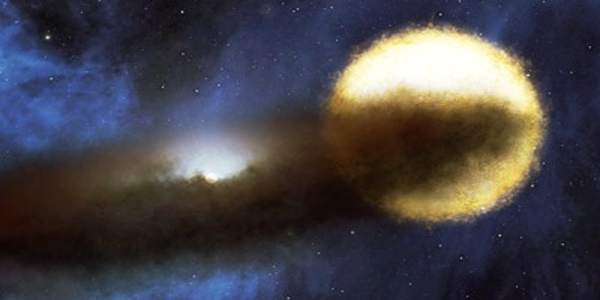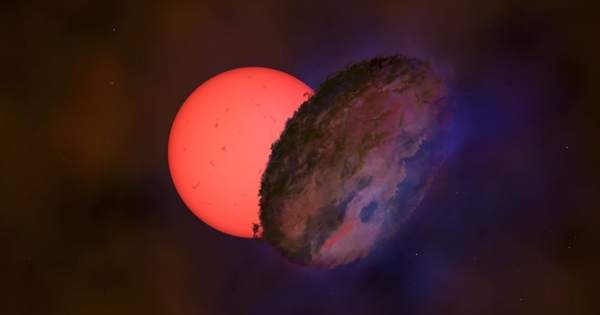Astronomers have discovered a massive ‘blinking’ star near the center of the Milky Way, over 25,000 light years away.
An international team of astronomers observed the star VVV-WIT-08 dimming by a factor of 30 and nearly disappearing from the sky. While many stars change brightness due to pulsation or being eclipsed by another star in a binary system, it is extremely rare for a star to become fainter over several months and then brighten again.
The researchers believe VVV-WIT-08 is part of a new class of ‘blinking giant’ binary star system, in which a giant star 100 times the size of the Sun is eclipsed once every few decades by an as-yet unseen orbital companion. The companion, which could be another star or a planet, is surrounded by an opaque disc that covers the giant star, causing it to vanish and reappearance in the sky. The research was published in the Royal Astronomical Society’s Monthly Notices.
Dr. Leigh Smith of Cambridge’s Institute of Astronomy led the research team, which included scientists from the Universities of Edinburgh, Hertfordshire, Poland’s University of Warsaw, and Chile’s Universidad Andres Bello.
Astronomers have spotted a giant ‘blinking’ star towards the centre of the Milky Way, more than 25,000 light years away.
“It’s incredible that we just observed a dark, large, and elongated object pass between us and a distant star, and we can only speculate as to its origin,” said co-author Dr. Sergey Koposov of the University of Edinburgh.
Because the star is in a dense region of the Milky Way, the researchers wondered if some unknown dark object had simply drifted in front of the giant star by chance. However, simulations revealed that for this scenario to be plausible, there would have to be an absurdly large number of dark bodies floating around the Galaxy.
Another star system of this type has long been known. Every 27 years, the giant star Epsilon Aurigae is partially eclipsed by a massive disc of dust, but it only dims by about 50%. A second example, TYC 2505-672-1, was discovered a few years ago and currently holds the record for the eclipsing binary star system with the longest orbital period — 69 years — a record that VVV-WIT-08 is vying for.

In addition to VVV-WIT-08, the UK-based team discovered two more of these strange giant stars, implying that these may be a new class of ‘blinking giant’ stars for astronomers to investigate.
VVV-WIT-08 was discovered by the VISTA Variables in the Via Lactea Survey (VVV), a project that has been observing the same one billion stars for nearly a decade to look for examples with varying brightness in the infrared part of the spectrum using the British-built VISTA telescope in Chile and operated by the European Southern Observatory.
Professor Philip Lucas of the University of Hertfordshire, project co-leader, stated, “We occasionally come across variable stars that don’t fit into any of the established categories, which we refer to as ‘what-is-this?’ or ‘WIT’ objects. We have no idea how these blinking giants came to be. It’s thrilling to see such discoveries from VVV after so many years of planning and data collection.”
While VVV-WIT-08 was discovered using VVV data, the star’s dimming was also observed by the University of Warsaw’s Optical Gravitational Lensing Experiment (OGLE), a long-running observation campaign. OGLE observes more frequently, but closer to the visible part of the spectrum. These frequent observations were critical for modeling VVV-WIT-08, as they revealed that the giant star dimmed by the same amount in visible and infrared light.
There appear to be about a half-dozen has known potential star systems of this type, each with giant stars and large opaque discs. “There are certainly more to be discovered,” Smith said. “The challenge now is determining what the hidden companions are and how they came to be surrounded by discs despite orbiting so far from the giant star.” “We might learn something new about how these kinds of systems evolve as a result.”
















